InterviewSolution
This section includes InterviewSolutions, each offering curated multiple-choice questions to sharpen your knowledge and support exam preparation. Choose a topic below to get started.
| 4401. |
A voltmeter having resistance of 1800 Omega is employed to measure the potential difference across 200 Omega resistance which is connected to DC power supply of 50 V and internal resistance 20 Omega. What is the percentage change in potential difference across 200 Omega resistance as a result of connecting voltmeter across it ? |
|
Answer» 0.01 Now, `V_(2)=50-(50)/(200)xx20=45` % change in POTENTIAL DIFFERENCE `=((45.5-45))/(50)xx100=1%` |
|
| 4402. |
A step-up transformer is used on a 120V line to provide a potential difference of 240V, if the primary coil has 75 turns the number of turns in the secondary coil is …….. |
|
Answer» 150 `epsilon_2/epsilon_1=N_2/N_1` `therefore 240/120=N_2/75` `therefore N_2`= 150 |
|
| 4403. |
A triode has a plate resistance of 10 k Omega and amplification factor 24. If the input signal voltage is 0.4 V(r.m.s), and the load resistance is 10 k ohm, then, the output voltage is (r.m.s.) is |
|
Answer» `4.8 V` Now `A=(24xx10k)/(10k+10k)=(24xx10)/20=12` THEREFORE, `V_(0)=12xx0.4=4.8` volt (r.m.s.) |
|
| 4404. |
The induced e.m.f. in a coil is independent of: |
|
Answer» CHANGE in the flux |
|
| 4405. |
Show that shock compression of a gas causes its entropy to rise. |
|
Answer» `(p_2)/(p_1) = (alpha x - 1)/(alpha -x) , (p_2)/(p_1) = x^(gamma) ,` therefore `(p_3)/(p_1) = (alphax - 1)/((alpha - x) x^(gamma))` The change in entropy as a resultof hte shock compression is equal to the change in entropy as a result of the isochoric cooling, only with the opposite sign. Making use of hte result of Problem. 18.14. we obtain `DeltaS_(sh) = - DeltaS_V = -m/M C_(MV) ln (T_1)/(T_2) = m/M C_(mV) ln (P_3)/(P_1)` `= m/M C_(mV) ln [(alphax - 1)/((alpha - x) x^(gamma))]` 
|
|
| 4406. |
A, B C and D are large condutingplates kept parallel each other,A and D are fixed. Plates B and C connected to each other by a rigied conduction rod, can slide over friction less rails as shown,Initially the distence between T^(1) ates C and D.If now the rod (along with plates B and C) is slightly moved toward right, the capacitance between the terminals 1 and 2 |
|
Answer» REMAINS UNCHANGED |
|
| 4407. |
A given charge is situated at a certain distance from an electric dipole in the end-on position experiences a force E If the distance of the charge is doubled, the force acting on the charge will be |
|
Answer» `2F` |
|
| 4408. |
Define refractive index of a transparent medium ? |
| Answer» SOLUTION :REFRACTIVE index of a transparent medium is DEFINED as the ratio of speed of LIGHT in free space (vaccum) to the speed of light in the given medium. | |
| 4409. |
यदि A={1, 2, 3} तथा B={3, 4, 1} हो तो A - B होगा |
|
Answer» {1, 2, 3, 4, 5} |
|
| 4410. |
What speed should a galaxy move with respect us to that the sodium line at 589.0nm is observed at 589.6nm? |
|
Answer» Solution :Since `v lambda= c`, `(TRIANGLE v)/(v)= -(triangle lambda)/(lambda)` (for small changes in v and `lambda`). For `triangle lambda= 589.6-589.0= +0.6nm` we get [using Eq. (3.9)] `(triangle v)/(v)= -(triangle lambda)/(lambda)= (-v_("raidial"))/(v)" or, "v_("RADIAL") cong +c ((0.6)/(589.0))` `= +3.06xx 10^(5)ms^(-1)= 306 KM"/"s` Therefore, the galaxy is movingaway from US. |
|
| 4411. |
A U^(235)nuclear reactor generates energy at rate of 3.70xx10^(7)J//s . Each fission liberates 185 MeV useful energy. If the reactor has to operate for 144 xx 10^(4) s , then the mass of the fuel needed is (Assume Avogadro.s number = 6 xx 10^(23) "mol"^(-1), 1eV = 1.6xx 10^(-19)J) |
|
Answer» 70.5 KG |
|
| 4412. |
In the YDSE apparatus shown in figure Deltax is the path difference between S_(2)P and S_(1)P. Now a glass slab is introduced in front of S_(2), then match the following. |
|
Answer» <P> |
|
| 4413. |
In a Galileo's telescope the focal lengths of the objective and the eyepiece are 0.3 m and 0.06 m respectively. Find the magnifying power and the length of the telescope. |
|
Answer» |
|
| 4414. |
A 2kg block is placed over a 5kg block and both are placed on a smooth horizontal surface. The coefficient of friction between the blocks is 0.10. Find the acceleration of the two blocks if a horizontal force of 14 N is applied to the upper block (g=10 ms^(-2)). |
|
Answer» Solution :Consider the MOTION of 2kg block. The forces on it are (i) gravitational force, `2g=2xx10=20N`. Vertically downwards, (ii) normal reaction N by the 5kg block, vertically upwards, (iii) force of friction `F = mu N` to the left and(iv) applied force 14 N.  In the VERTICAL direction, there is no acceleration. `therefore N = 20 N` In the horizontal direction, the acceleration of the 2kg block is a. `therefore 14-mu N = 2A ""` (`because` Resultant force = ma) `14-0.10xx20=2a(mu=0.10)` `14-2=2a , a = 6 MS^(-2)`. Consider the motion of 5kg block. The forces on it are (i) gravitational force `5g=5xx10=50N`, vertically downwards, (ii) normal reaction N of the horizontal surface, vertically upwards (iii) force of friction `f = mu` N to the right by Newton.s third law of motion and (iv)normal reaction, N downwards by 2kg block. In the vertical direction, there is no acceleration. `therefore N = 50 N`. In the horizontal direction, the acceleration of the 5kg block is .a.. `mu N = 5a`. `rArr 0.10 xx20=5a. , a. = 0.4 ms^(-2)`. |
|
| 4415. |
The vessel shown in the figure has two sections of area of cross - section A_(1) and A_(2).A liquid of density rho fills boththe section upto a height h in each . Consider atmospheric pressure P_(0) also . Find (a) the pressure at the base of vessel .(b) the force exerted by the liquid on the base of the vessel . (c ) the downwardforce exerted by the walls of the vessel at the level B |
|
Answer» Solution :`P_("Bass") = P_(0)+rhog2h` (B) Force applied by the LIQUID on the base ` = (P_(0)+2 rho GH )A_(2)` (c )DOWNWARD force by the walls of the vessel at level `B(N_(b))` = Pressure at `B xx Area ` at the level B . = `(P_(0)+rhogh) (A_(2)-A_(1))` Alternatively `P_(0)A_(1)+N_(B)+(A_(1)H+A_(2)h)rhog = (P_(0)+2rhogh)A_(2)` `N_(B) = P_(0)A_(2) +2rhoghA_(2) - P_(0)A_(t) - A_(1)h_(1)rhog - A_(2) hrhog` ` = (P_(0)+h rho g) (A_(2) - A_(1))` 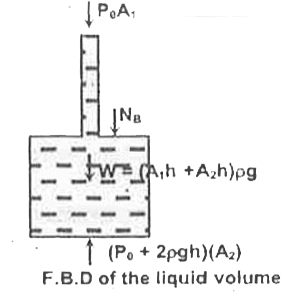
|
|
| 4416. |
Let f: Rrarr R be defined by f (x) = 4x+5, then f is- |
|
Answer» One-one |
|
| 4417. |
Define electric potential. Derive and expression for the electric potential due to an electric dipole and hence the electric potential at a point (a) the axial line of electric dipole (b) on the equatorial line of electric dipole. |
|
Answer» Solution :Electric potential (V): The workdone by a unit positive charge from infinite to a point in an electric field called electric potentials. 1. Consider A and B having -q and +q charges separated by a distance 2a. 2. The electric dipole moment `P=qxx2a` along AB. 3. The electric potential at the point 'P' is to be CALCULATED. 4. P is at a distance 'r' from the point 'O'. `theta` is the angle between the line OP and AB. 5. BN and AM are perpendicular to OP. 7. Potential at P due to charge `-q at A, V_2=(1)/(4 pi epsi_0)[(-q)/(AP)]` `therefore V_1=(1)/(4pi epsi_0)[(-q)/(MP)][because AP=MP]` 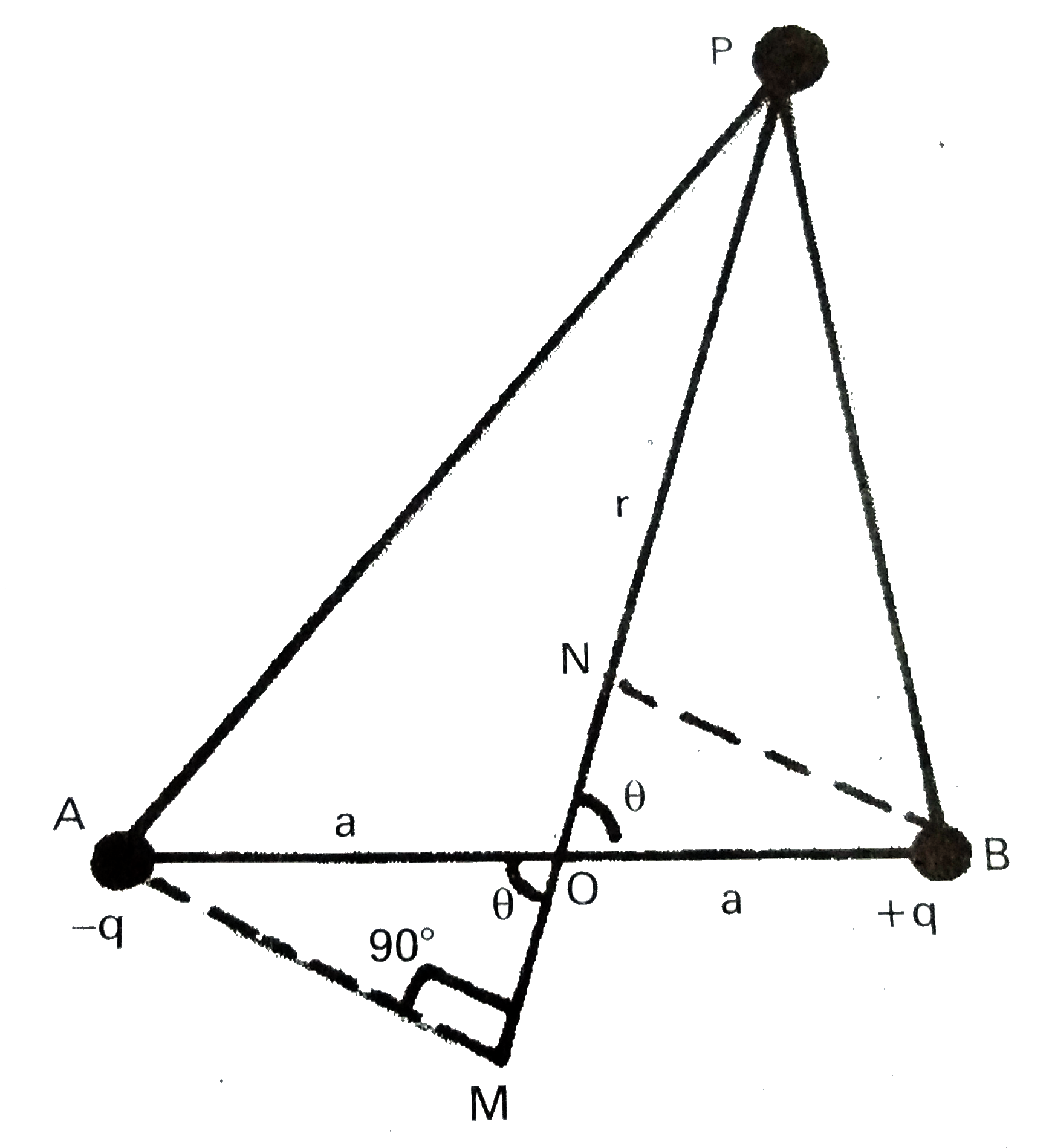 8. Therefore , Resultant potential at P is `V=V_1+V_2` `V=(1)/(4piepsi_0)[(q)/(NP)-(q)/(MP)]`..............(1) 9. In `Delta le ONB,ON=OB cos theta =a cos theta, therefore NP=OP -ON=r-a cos theta`............(ii) 10. In `Delta le AMO,OM=AO cos theta=a cos theta, therefore MP=MO+OP=r+a cos theta`............(3) 11. SUBSTITUTING (2) and (3) in (1) , we GET `V=(1)/(4 pi epsi_0)[(q)/(r-a cos theta)-(q)/(r+acos theta)]=(q)/(4 pi epsi_0)[(2acos theta)/(r^2-a^2cos^2theta)]` `therefore V=(P cos theta)/(4pi epsi_0(r^2-a^2cos^2theta))[because P=2aq]` 12. As ` r gtgt a , a ^2cos^2 theta` can be neglected with comparision of `r^2`. `therefore V=(Pcos theta)/(4pi epsi_0r^2)` 13. (a) Electric potential on the axial line of dipole : (i) When `theta=0^@`. Point p line on the side of `+q` `therefore V=(P)/(4piepsi_0r^2) [because cos 0^@=1]` (ii) When `theta=180^@`, point p lies on the side of -q . `therefore V=(-P)/(4piepsi_0r^2) [because cos 180^@=-1]` (b) Electric potential on the equitorial ine of the dipole : when `theta=90^@`, point P lies on the equitorial line. `therefore V=0 [ because cos 90^@=0]`. 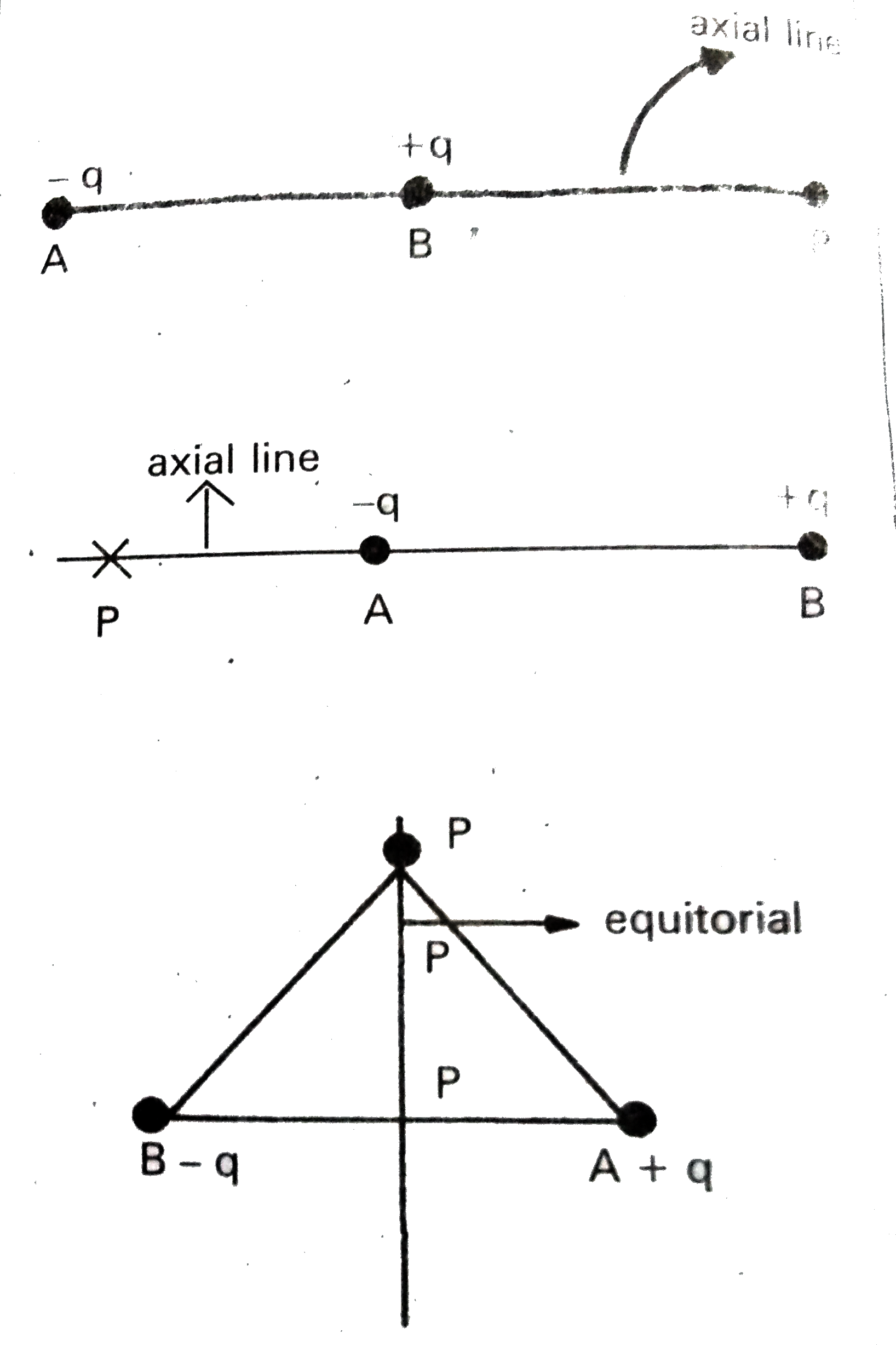
|
|
| 4418. |
The capacitance of a capacitor having .a charge 6xx10^-7C and energy 4.5xx10^-4J is : |
|
Answer» `4xx10^-10F` |
|
| 4419. |
A cell develops the samepower across two resistance R_(1) and R_(2) separately. The internal resistance of the cell is |
|
Answer» Solution :Let r be the internal RESISTANCE of the cell and E its EMF. When connected across the resistance `R_(1)` in the CIRCUIT, current passing through the resistance is `i=(E)/(R_(1)+r)""THEREFORE""P_(1)=i^(2)R_(1)=((E)/(R_(1)+rr))^(2)R_(1)` SIMILARLY `P_(2)-((E)/(R_(2)+r))^(2)R_(2)" Given that "P_(1)=P_(2)` Substituting the values, we get `r=sqrt(R_(1)R_(2))` |
|
| 4420. |
A charged particle moves through a magnetic field in a direction perpendicular to it. Then the |
|
Answer» VELOCITY REMAINS unchanged |
|
| 4421. |
which of the following is equal to x ? |
|
Answer» `X^(12/7) -X^(5/7)` |
|
| 4422. |
Draw a simplified diagram showing working of Nuclear Power Plant. |
|
Answer» Construction. It consists of thick blocks of graphite in which LONG cylindrical holes have been drilled . Fissionable material is inserted through these holes. Fuel. It consists of certain mass of fissionable material taken in the form of rod of few centimetres in diameter. It may consist of enriched uranium which is 3.5 % uranium -235 and 96.5% of uranium-238. Moderator. To slow down the neutrons, they must suffer collision against atoms of material of moderator. Suitable material used as moderator are heavy water and graphite. 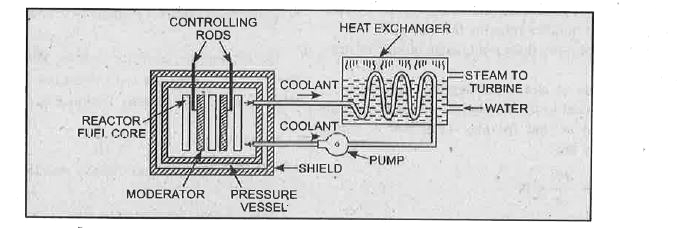 Controlling rods. Cadmium rods are used as controlling rods. The rods are inserted in the reactor and the chain reaction is controlled by careful adjustment of their length inside the carbon blocks. The movement of a cadmium rod by a little (say one cm distance) causes a significant difference in the performance of the reactor. Working. Neutrons produced by the action of `alpha`- particle on polonium or beryllium are slowed down and are used initially to bring about fission of say `U^(235)` nuclei. The emitted neutrons are slowed down by the passage through the moderator to split further `U^(235)` NUCLEUS. The chain reaction is said to be steady so that effective multiplication factor `K_(e)` is 1. `K_(e)=("Rate of emission of neutrons")/("Rate of loss of neutrons")` Some lost neutrons are absorbed by `""_(92)U^(238)` present in enriched uranium which gives rise to `""_(94)U^(239)` as shown below: `""_(0)n^(1)+""_(92)U^(238)rarr ""_(92)U^(239)rarr""_(-1)beta^(0)+""_(93)Np^(239)` `""_(93)Np^(239) rarr ""_(-1)beta^(0)+""_(94)Pu^(239)` `""_(94)Pu^(239)` is produced as a bye-product and can be used for fission purpose. India used `""_(94)Pu^(239)` in nuclear device which was exploded on 18th May 1974 and later on May 11 and 13, 1998 at Pokhran. Uses. A nuclear reactor is used for generation of electricity, preparation of radio-isotopes. Most of energy set free is in the form of heat which through heat exchange is made to FURNISH steam to operate conventional turbined and electricgenerators. 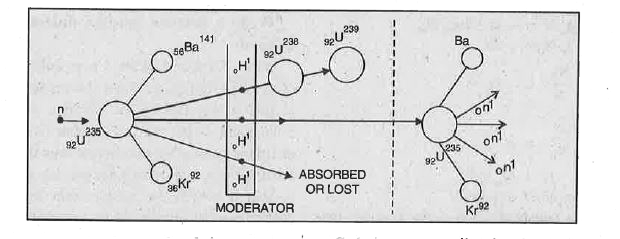
|
|
| 4423. |
If we seal a pipe with two metal end caps around a point charge Q, the electric field outside the pipe will be |
|
Answer» identical to the FIELD of an isolated point CHARGE |
|
| 4424. |
Average voltage for the given source is : |
|
Answer» `V_(0)` |
|
| 4425. |
A body is projected upwards with a velocity of 19.6 m/s. Find the time of ascend. G = 9.8 m / s^2. |
| Answer» SOLUTION :If 't' is the TIME of ascent, then from `V = u+gt`, We get `0 = 19.6 - 9.8t` or `t = 2 secs`. | |
| 4426. |
In a single-slit diffraction experiment, a monochromatic source of light of wavelength 'lamda' illuminates a narrow slit of width 'a'. Show, giving appropriate reasoning, that the half angular width of the central maximum in the observed pattern is (nearly) equal to (lamda)/(a). |
|
Answer» Solution :In a single-slit diffraction experiment, at the CENTRE point on the SCREEN we get central diffraction maxima. The first diffraction minima is given by the condition `asintheta=pmlamda or sintheta=pm(lamda)/(a)` If `theta` is small then `sintheta=theta=pm(lamda)/(a)` It SHOWS that central diffraction maxima extends from `theta=0` to `theta=pm(lamda)/(a)`. it means that the HALF ANGULAR width of the central maxima in diffraction pattern is `(lamda)/(a)`. |
|
| 4427. |
A conducting sphere of radius b hasspherical cavity with its centre displaced by "a" from centre of sphere, A point charge q is placed at the centre of cavity. .Q. charge is given to conducting sphere and charge q_(o) is placed at a distance c from centre (O_(1)) of sphere such that O_(1) and O_(2) and p are collinear |
|
Answer» charge distribution on inner surface of cavity is uniform |
|
| 4428. |
Statement-1: Two particles moving in the same direction do not lose all their energy in a completely inelastic collision.Statement-2: Principle of conservation of momentum holds true for all kinds of collisions. |
|
Answer» STATEMENT-1 is true, Statement-2 is false. |
|
| 4429. |
A radioactive sample has activity of 10,000 disintegrations per second after 20 hours. After next 10 hours its activity reduces to 5,000 disintegrations per second. Find out its half-life and initial activity. |
|
Answer» Solution :At time `t_(1) = 20h` the ACTIVITY of radioactive SAMPLE `R_(1) = 10,000 Bq` and after next 10h i.e., at time `t_(2) = 20 + 10 = 30 H` the activity `R_(2) = 5,000 Bq=R_(1)/2`. `implies` Half-life period `T_(1/2) = t_(2) - t_(1)=10h` If initial activity be `R_(0)`, then `R_(1) = R_(0)(1/2)t_(1)/T_(1/2) implies 10,000-R_(0)(1/2)^(20/10)=R_(0)(1/2)^(2)=R_(0)/4 implies R_(0)=4xx10,000=40,000Bq` |
|
| 4430. |
Calculate the separation of the particles and the binding energy of a positronium (an atom consisting of an electron and a position revolving around their centre of mass). |
|
Answer» |
|
| 4431. |
What we call to the rainbow formed by light rays which have suffered two total internal reflection is called ? |
| Answer» SOLUTION :SECONDARY RAINBOW | |
| 4432. |
Explainwithcircult diagramhowto convertgalavanmeterintoa voltmeter . |
Answer» Solution :Toconverta galvanometerintoa voltmeter, ahighresistanceis convectedinserieswiththe COIL. Thegalvaniometerwiththismodificationis CALLEDA voltmeter.Thevalue of thehighresistanceR toconnectedin serieswiththecoildependsonthe maximumpotentialdifferenceto bemeasuredif`I _(g )`be thecurrentfora fullscaledeflectionthen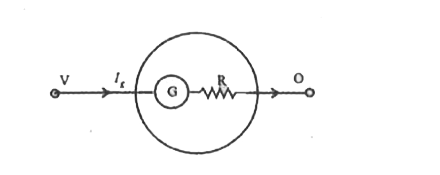 `V= I_(g)(G+R)` Gis theresistanceof thegalvanometer . ` thereforeR = (V )/(I_(g))- G ,I_(g) prop V` SinceG and Rareconstants, thescalecan begraduatedto readpotentialdifferencedireectly. avoltmeteris usedformeasurementofpotentialdifferernce.Itshouldbe connectedin parallelin acircult. |
|
| 4433. |
A cell of e.m.f 2 volt and internal resistance 1.5Omega is connected to the ends of 1m long wire. The resistance of wire is 0.5Omega//m. Find the value of potential gradient on the wire. |
| Answer» Solution :`X=(IR)/(L )=((E)/(R+r))(R )/(L)=(2xx0.5)/(0.5+1.5)=0.5V//m` | |
| 4434. |
Electromagnets are made of soft iron, because soft iron has |
|
Answer» LOW susceptibility and low retentivity |
|
| 4435. |
a. For the calculation of average angle of scattering of a particles by a thin foil, why multiple scattering cannot be ignored in Thomson's model?b. Name the model in which it can be ignored.c. The majority of a particles pass through gases with no deflections. To what conclusion about the atomic structure does this observation lead? |
|
Answer» Solution :a. Positive charge is uniformly distributed in the WHOLE atom of the Thomson.s model. If only SINGLE COLLISION is considered, it cannot cause large deflection, so multiple scattering is considered to CALCULATE average angle of scattering. Thus multiple scattering cannot be ignored in Thomson.s model. b. It can be ignored in Rutherford.s model because scattering is mainly because of single collision in this model. c. This observation LEADS to the conclusion that most of the space in the atom is empty. |
|
| 4436. |
The network shown in figure is a part of the circuit. (The battery has negligible resistance) At a certain instant the current I = 5A and is decreasing at a rate of 10^3 As^(-1). What is the potential difference between point B and A ? |
|
Answer» 5V  Taking direction from A to B , the kirchoff.s LAW , `V_A-IR+EPSILON-(-L(DI)/(dt))=V_B` `therefore -IR+epsilon+(LdI)/(dt)=V_B-V_A` Here `R=1 OMEGA , I=5A , (dI)/(dt) =10^3` A/s , L=5 mH, `epsilon`=15 V `therefore -5xx1+15+5xx10^(-3)xx10^3=V_B-V_A` `therefore -5+15+5=V_B-V_A` `therefore V_B-V_A` =15 V |
|
| 4437. |
Figure 26-11 shows a swimmer at distance D=38.0 m from a lightning strike to the water, with current I=78kA. The water has resistivity 30 Omega.m, the width of the swimmer along a radial from the strike is 0.70m, and his resistance across that width is 4.00kOmega. Assume that the current spreads through the water over a hemisphere centered on the strike point. What is the current through the swimmer? Swimmer at a distance of 38m from where lightning strikes water. |
|
Answer» Solution :Since the current spreads over the hemisphere, the current density at any given radius r from the striking POINTS is `J=I/2 pir^(2)`. From Eq. 26-10, the magnitude of the elctric field at a distance r is `E=p_(w)J=(p_(w)J)/(2pir^(2))," where "p_(w)=30Omega`. is the RESISTIVITY of water. The potential differnce a point at radical distance D and a point at `D+triangler` is `E=-int_(D)^(D+triangler) Edr. =-int_(D)^(D+triangler) (p_(W)I)/(2pir^(2)) dr` `=-(p_(W)I)/(2pir) ((1)/(D+triangler)-1/D)=-(p_(W)I)/(2pir) (triangler)/(D(D+triangler))` which implies that the current ACROSS the swimmer is `i=(|triangleV|)/(R)=(p_(w)I)/(2pir)(triangler)/(D(D+triangler))` Calculations: Substituting the VALUES given, we obtain `i=((30.0 Omega.m) (7.80 xx 10^(4) A))/(2PI (4.00 xx 10^(3) Omega)) (0.70m)/((38.0m) (38.0 m+0.70m))` `=4.43 xx 10^(-2)A` |
|
| 4438. |
A ray of light travelling in air is incident at grazing angle (incidence angle = 90^(@)) on a medium whose refractive index depends on the depth of the medium. The trajectory of the light in the medium is a parabola, y=2x^(2). Find, at a depth of 1 m in the medium (i) the refractive index of the medium and (ii) angle of incidence phi. |
|
Answer» |
|
| 4439. |
During isobaric expansion number of collisioins of gaseous molecules wave wall of container keeps on increasing. |
|
Answer» |
|
| 4440. |
A plane light wave with wavelength lambda = 0.54 mu m goes through a thin converging lens with focal length f = 50 cm and an aperture stop fixed immediately after lens, and reaches a screen placed at a distance b = 75 cm from the aperture stop. At what aperture radii has the centre of the differaction pattern on the screen the maximum illuminance ? |
|
Answer» Solution :Here the focal point acts as a virtual source of LIGHT. This MEANS that we can take spherical waves converging towards `F`. Let us divide these waves into Fresnel zones just after they energy from the stop. We write `r^(2) = f^(2) - (f -h)^(2) = (b - mlambda//2)^(2) - (b - h)^(2)` Here `r` is the radius of the `m^(th)` fresnel zone and `h` is the distance to the left of the food of the PERPENDICULAR. Thus `r^(2) = 2fh = -bm lambda + 2bh` So `h = bm lambda//2(b - f)` and `r^(2) = fbm lambda//2(b - f)`. The intensity maxima are observed when an oss number of Fresnel zones are exposed by the stop. Thus `r_(k) = SQRT((kbf lambda)/(b - f))` where `k = 1, 3, 5.......` 
|
|
| 4441. |
If radius of ""_(13)^(27)Al is 3.6 Fermi, then radius of ""_(52)^(125)Te is nearly |
|
Answer» 4 Fermi `R_(2)/R_(1)=(A_(2)/A_(1))^(1//3)=((125)/(27))^(1//3)` `R_(2)/R_(1)=5/3 rArr R_(2)=5/3 XX R_(1)=5/3 xx 3.6` `R_(2)=6" Fermi"` |
|
| 4442. |
The radius of a circular ring of wire is R and it carries a current of I ampere. At its centre a smaller ring of radius r with current i and N turns is placed. Assuming that the planes of two rings are perpendicular to each other and the magnetic induction produced at the centre of bigger ring is constant, then the torque acting on smaller ring will be - |
|
Answer» `Nipir^(2) XX {(mu_(0)I)/(2R)}` |
|
| 4443. |
Electric potential at the center 'C' of the square of a side 'a' is |
| Answer» Answer :A | |
| 4444. |
A passenger standing in a bus is thrown outwards when the bus has a sudden turn. This happens because of |
|
Answer» OUTWARD PULL on them |
|
| 4445. |
A uniform cylinder of the radius R ( = 3 m) is spin about its axis at an angular velocity omega_(0)(=40 sqrtpi" rad s"^(-1)) and placed between two perpendicular walls. The coefficient of friction between the walls and cylinder is mu(=2). Then, how many rotations will the cylinder make before it comes to rest? |
|
Answer» |
|
| 4446. |
A folded plate OABCDEFO made of materials such that part OABO (say part(i), BCDOB hs mass 4m, m and m respectively. Part (i) is a uniform semicircular plate of radius R//2 and in on the xy plane. Part (ii) and (iii) each is a uniform quarter circular plate of radius R on xy and xz plane respectively. The whole system is free to rotate about y-axis A particle P of mass m moving with velocity v_(0) hits to a point located at the circumcentre of the part (iii) and sticks to it. The point is at a distance R//2 from x -axis as shown in the figure. Angular velocity of the combined system just after the collision is |
|
Answer» `(v_(0))/(4R)` `=(4m(R/2)^(2))/4+(mR^(2))/4+(mR^(2))/2+mR^(2)=2mR^(2)` Conservation of ANGULAR MOMENTUM ALONG `y`-axis `mv_(0) R/2=2mR^(2)omega` `omega=(v_(0))/(4R)` |
|
| 4447. |
The magnetic field at the centre O of the are shown in the figure is |
|
Answer» `2I(SQRT(2)+PI)XX(10^(-7))/(R)` |
|
| 4448. |
If a substance moves from the stronger to the weaker parts of a non-uniform magnetic field, then it is known as __________. |
|
Answer» PARAMAGNETIC |
|
| 4449. |
Give one example of point-to-point communication mode. |
| Answer» SOLUTION :TELEPHONE CALL, MICROWAVE RELAY. | |
| 4450. |
A slideprojecto gives magnification of 10. If a slide of dimensions 3 cm xx 2 cm is projector on screen, the area of image on screen is : |
|
Answer» `300 CM^(@)` AREAL magnification = `10^(2) = 100` `therefore (A_(2))/(A_(1)) = 100` `A_(2) = A_(1) xx 100` `3 xx 2 xx 100` `600 cm^(2)` |
|